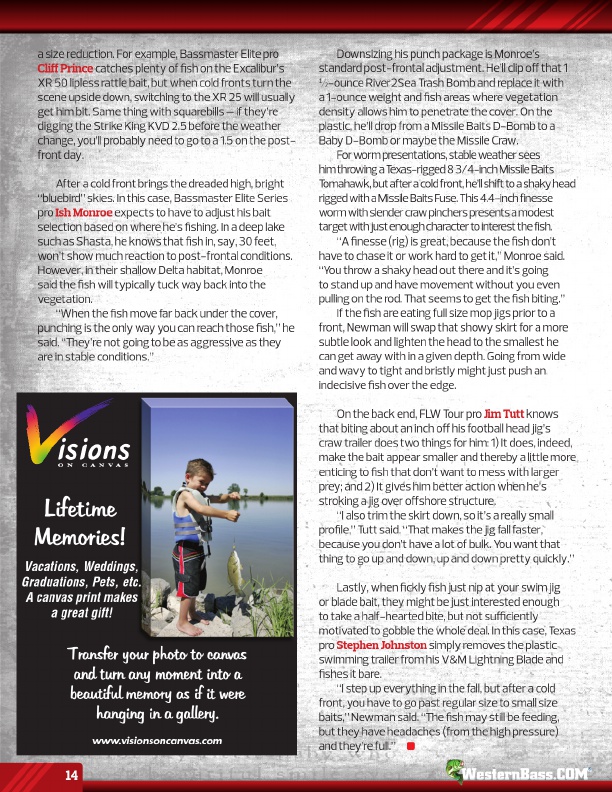
a size reduction. For example, Bassmaster elite pro Cliff Prince catches plenty of fish on the excalibur’s Xr 50 lipless rattle bait, but when cold fronts turn the scene upside down, switching to the Xr 25 will usually get him bit. Same thing with squarebills – if they’re digging the Strike King KVd 2.5 before the weather change, you’ll probably need to go to a 1.5 on the post- front day.
after a cold front brings the dreaded high, bright “bluebird” skies. in this case, Bassmaster elite Series pro ish Monroe expects to have to adjust his bait selection based on where he’s fishing. in a deep lake such as Shasta, he knows that fish in, say, 30 feet, won’t show much reaction to post-frontal conditions. However, in their shallow delta habitat, Monroe said the fish will typically tuck way back into the vegetation. “When the fish move far back under the cover, punching is the only way you can reach those fish,” he said. “They’re not going to be as aggressive as they are in stable conditions.”
downsizing his punch package is Monroe’s standard post-frontal adjustment. He’ll clip off that 1 ½-ounce river2Sea trash Bomb and replace it with a 1-ounce weight and fish areas where vegetation density allows him to penetrate the cover. on the plastic, he’ll drop from a Missile Baits d-Bomb to a Baby d-Bomb or maybe the Missile Craw. For worm presentations, stable weather sees him throwing a t exas-rigged 8 3/4-inch Missile Baits t omahawk, but after a cold front, he’ll shift to a shaky head rigged with a Missile Baits Fuse. this 4.4-inch finesse worm with slender craw pinchers presents a modest target with just enough character to interest the fish. “a finesse (rig) is great, because the fish don’t have to chase it or work hard to get it,” Monroe said. “You throw a shaky head out there and it’s going to stand up and have movement without you even pulling on the rod. That seems to get the fish biting.” if the fish are eating full size mop jigs prior to a front, Newman will swap that showy skirt for a more subtle look and lighten the head to the smallest he can get away with in a given depth. Going from wide and wavy to tight and bristly might just push an indecisive fish over the edge.
on the back end, FlW tour pro Jim Tutt knows that biting about an inch off his football head jig’s craw trailer does two things for him: 1) it does, indeed, make the bait appear smaller and thereby a little more enticing to fish that don’t want to mess with larger prey; and 2) it gives him better action when he’s stroking a jig over offshore structure. “i also trim the skirt down, so it’s a really small profile,” tutt said. “That makes the jig fall faster, because you don’t have a lot of bulk. You want that thing to go up and down, up and down pretty quickly.”
lastly, when fickly fish just nip at your swim jig or blade bait, they might be just interested enough to take a half-hearted bite, but not sufficiently motivated to gobble the whole deal. in this case, texas pro Stephen Johnston simply removes the plastic swimming trailer from his V&M lightning Blade and fishes it bare. “i step up everything in the fall, but after a cold front, you have to go past regular size to small size baits,” Newman said. “The fish may still be feeding, but they have headaches (from the high pressure) and they’re full.”
®
Lifetime Memories!
Vacations, Weddings, Graduations, Pets, etc. A canvas print makes a great gift!
Transfer your photo to canvas and turn any moment into a beautiful memory as if it were hanging in a gallery.
www.visionsoncanvas.com
14
http://www.visionsoncanvas.com